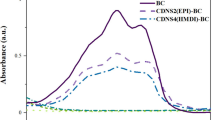Abstract
The PEGylated gelatin nanoparticles were prepared by self-assembling method and characterized. The gelatin drug carrier was proposed as a targeting drug delivery system with the hypothesis that the gelatin carrier could be degraded by the matrix metalloprotease (MMP) and release the anticancer drug loaded inside carriers around the cancer site. The gelatin nanoparticles proposed in this study were composed of deoxycholic acid (DOCA), monomethoxy polyethylene glycol (MPEG), and gelatin. The carboxyl groups of DOCA and carboxylated MPEG were coupled with amine group of gelatin by dichlorohexylcarbodiimide (DCC) method. One molecule of gelatin coupled with 205 molecules of MPEG and 275 molecules of DOCA. The synthesized gelatin/DOCA/MPEG conjugates (GDM) were ultrasonicated to produce self-assembled nanoparticles. DOCA acted as the hydrophobic core, thereby aggregating gelatin molecules and hydrophilic MPEG chains located at the surface of the nanoparticles. The concentration of GDM, intensity of sonication, sonication time and temperature, all affected to control the particle size in the ultrasonication. The optimum condition was obtained as 1.0 mg/mL of GDM, 28 W for sonication intensity, 3 min of sonication time, and room temperature. The size distribution of particle was found to be 100–1000 nm in this condition. The particles which had a broad size distribution were filtered by 0.2 μm membrane. The product yield of particles having below 200 nm of size was about 30%. After filtration, an average diameter of GDM nanoparticle was 176 nm (155–200 nm).
Similar content being viewed by others
References
Whitesides, G. M., J. P. Mathias, and C. T. Sato (1991) Molecular self-assembly and nanochemistry: a chemical strategy for the synthesis of nanostructures.Science 254: 1312–1319.
Nishikawa, T., K. Akiyoshi, and J. Sunamoto (1996) Macromolecular complexation between bovine serum albumin and the self-assembled hydroge nanoparticle of hydrophobized polysaccharides.Macromolecules 26: 3062–3068.
Lee, K. Y., W. H. Jo, I. C. Kwon, Y. H. Kim, and S. Y. Jeong (1998) Physiochemical characteristics of self-aggregates of hydrophobically modified chitosans.Langmuir 14: 2329–2332.
Kreuter, J. (1983) Evaluation of nanoparticles as drug delivery systems II: comparison of the body distribution of nanoparticles emulsions.Pharm. Acta Helv. 58: 217–226.
Litzinger, D. C., M. J. Buiting, N. Rooijen, and L. Huang (1994) Effects of liposome size on the circulation time and intraorgan distribution of amphipathic poly (ethylene glycol) containing liposomes.Biochim. Biophys. Acta 1190: 90–107.
Blood, C. H. and B. R. Zetter (1990) Tumor interactions w with vasculature: Angiogenesis and tumer metastasis.Biochim. Biophys. Acta 1032: 89–118.
Dmore, P. A. (1992) Capillary growth: a two-cell system.Semin. Cancer Bull. 3: 49–56.
Coombes, A. G. A., S. Tasker, M. Lindblad, J. Holmgren, K. Hoste, V. Toncheva, E. Schacht, M. C. Davies, L. Illum, and S. S. Davis (1997) Biodegradable polymeric mcroparticles for drug delivery and vaccine formulation.Biomaterials 18: 1153–1161.
Peracchia, M. T., R. Gref, Y. Minamitake, A. Domb, L. Lotan, and R. Langer (1997) PEG-coated nanospheres from amphiphilic diblock and multiblock copolymers: investigation of their drug encapsulation and release characteristics.J. Control. Rel. 46: 223–231.
Peracchia, M. T., C. Vauthier, F. Puisieux, and P. Couvreur (1997) Development of sterically stabilized poly(isobutyl 2-cyanoacrylate) nanoparticle by chemical coupling of poly(ethyleneglvcol).Biomed. Mater. Res. 34: 317–326.
Nagaoka, S, Y. Mori, H. Tanzawa, Y. Kikuchi, H. Inagaki, Y. Yokota, and Y. Noishiki (1987) Hydrated dynamic surfaces.Trans. Am. Soc. Artif. Intern. Organs 10: 76–78.
Park, K. D., T. Okano, C. Nojiri, and S. W. Kim (1988) Heparin immobilization onto segmented polyurethaneurea surfaces: effect of hydrophilic spacers.J. Biomed. Mater. Res. 22: 977–992.
Partidge, C. A., P. G. Phillips, M. J. Niedbals, and J. J. Jeffrey (1977) Localization and activation of type IV collagenase/gelatinase at endothelial focal contacts.Am. J. Physiol. 272: 813–822.
Zalipsky, S., C. Gilon, and A. Zilkha (1983) Facile synthesis of α-hydroxy-w-carboxymethyl-polyethylene oxide.J. Bioactive Compatible Polymers 5: 227–231.
Author information
Authors and Affiliations
Corresponding author
Rights and permissions
About this article
Cite this article
Kim, K.J., Byun, Y. Preparation and characterizations of self-assembled PEGylated gelatin nanoparticles. Biotechnol. Bioprocess Eng. 4, 210–214 (1999). https://doi.org/10.1007/BF02931931
Issue Date:
DOI: https://doi.org/10.1007/BF02931931




